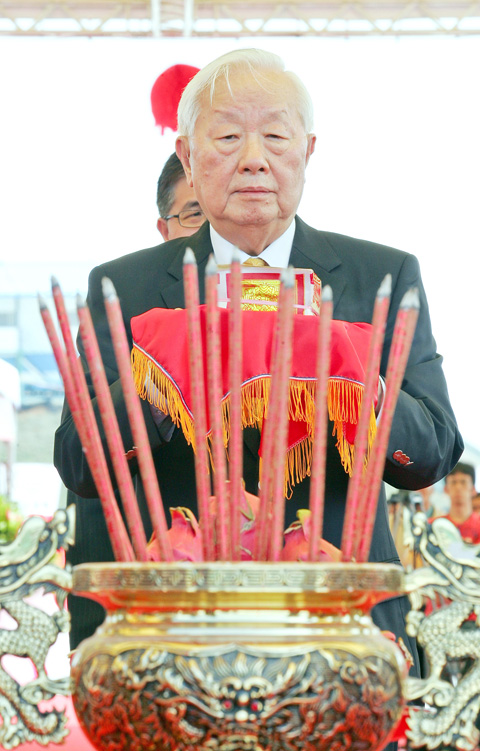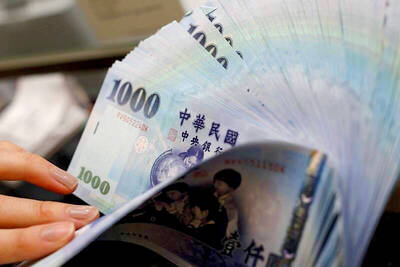Taiwan Semiconductor Manufacturing Co (TSMC, 台積電), the world’s largest contract chip maker, yesterday said it planned to spend more than NT$300 billion (US$9.34 billion) over the next few years to invest in a new chip plant in Taichung, which would create 8,000 jobs.
The company yesterday held a groundbreaking ceremony for the new semiconductor fabrication plant, or “Fab 15,” in Taichung, which was conducted by chairman and CEO Morris Chang (張忠謀).
The new facility will incorporate solar power and LED lighting with a goal of zero greenhouse gas emissions, Chang said.

PHOTO: BLOOMBERG
Fab 15 is set to create the 8,000 jobs as TSMC seeks to hire talented workers to run the fab, Chang said in a statement.
Mark Liu (劉德音), senior vice president of operations, told Bloomberg Newswires before yesterday’s ceremony that the company expects to hire up to 4,000 engineers at the site.
The factory will be TSMC’s third so-called “gigafab,” or fab with production capacity of more than 100,000 12-inch wafers per month.
It will also be the company’s second Gigafab equipped for 28-nanometer technology, the company said in the statement.
Construction of the new fab will be divided into four phases — with the first phase to start in June next year. The total investment for the fab would exceed NT$300 billion, the company said.
The fab is expected to start churning out 40nm and 28nm technology products for customers in the first quarter of 2012. More advanced process nodes will follow, it added.
The chipmaker also said yesterday that it would continue to expand capacity at its Fab 12 in Hsinchu and Fab 14 in Tainan.
“Combined capacity of Fab 12 and Fab 14 currently exceeds 200,000 12-inch wafers per month, and the total number will exceed 240,000 by the end of this year,” the statement read.
TSMC, whose clients include Qualcomm Inc and Nvidia Corp, is expanding quickly after posting record sales last quarter amid soaring global demand for computers and digital electronics.
Chang said last month the company was likely to increase capital spending again from a record high of US$4.8 billion to match the pace of a faster-than-expected recovery in electronics demand.
TSMC started increasing capital expenditures in September when it detected that a swift rebound was causing capacity constraints, bringing last year’s capital spending to US$2.7 billion in total, almost double the originally planned US$1.5 billion.
“TSMC is building out capacity now which will be yet another drag on margins over the near-term,” Bank of America Merrill Lynch said in a research note on July 12.
While the Taichung fab would focus on solar business, TSMC is also building its first LED fab in Hsinchu and expects it to be ready for mass production in the first quarter of next year, the note said.

Merida Industry Co (美利達) has seen signs of recovery in the US and European markets this year, as customers are gradually depleting their inventories, the bicycle maker told shareholders yesterday. Given robust growth in new orders at its Taiwanese factory, coupled with its subsidiaries’ improving performance, Merida said it remains confident about the bicycle market’s prospects and expects steady growth in its core business this year. CAUTION ON CHINA However, the company must handle the Chinese market with great caution, as sales of road bikes there have declined significantly, affecting its revenue and profitability, Merida said in a statement, adding that it would

MARKET LEADERSHIP: Investors are flocking to Nvidia, drawn by the company’s long-term fundamntals, dominant position in the AI sector, and pricing and margin power Two years after Nvidia Corp made history by becoming the first chipmaker to achieve a US$1 trillion market capitalization, an even more remarkable milestone is within its grasp: becoming the first company to reach US$4 trillion. After the emergence of China’s DeepSeek (深度求索) sent the stock plunging earlier this year and stoked concerns that outlays on artificial intelligence (AI) infrastructure were set to slow, Nvidia shares have rallied back to a record. The company’s biggest customers remain full steam ahead on spending, much of which is flowing to its computing systems. Microsoft Corp, Meta Platforms Inc, Amazon.com Inc and Alphabet Inc are

RISING: Strong exports, and life insurance companies’ efforts to manage currency risks indicates the NT dollar would eventually pass the 29 level, an expert said The New Taiwan dollar yesterday rallied to its strongest in three years amid inflows to the nation’s stock market and broad-based weakness in the US dollar. Exporter sales of the US currency and a repatriation of funds from local asset managers also played a role, said two traders, who asked not to be identified as they were not authorized to speak publicly. State-owned banks were seen buying the greenback yesterday, but only at a moderate scale, the traders said. The local currency gained 0.77 percent, outperforming almost all of its Asian peers, to close at NT$29.165 per US dollar in Taipei trading yesterday. The

The US overtaking China as Taiwan’s top export destination could boost industrial development and wage growth, given the US is a high-income economy, an economist said yesterday. However, Taiwan still needs to diversify its export markets due to the unpredictability of US President Donald Trump’s administration, said Chiou Jiunn-rong (邱俊榮), an economics professor at National Central University. Taiwan’s exports soared to a record US$51.74 billion last month, driven by strong demand for artificial intelligence (AI) products and continued orders, with information and communication technology (ICT) and audio/video products leading all sectors. The US reclaimed its position as Taiwan’s top export market, accounting for